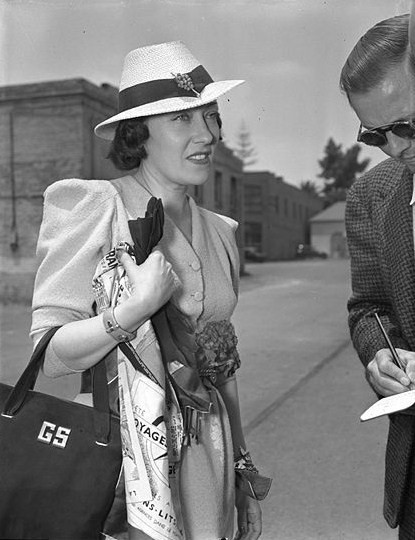Screenshot from a clip of the movie "Sunset Boulevard," via Wikimedia Commons
Today audiences remember actress Gloria Swanson only for playing the washed-up silent movie star Norma Desmond in Sunset Boulevard, but she lived a life similar to that of the character who made her immortal. Once the biggest silent star of the 1920s, she starred alongside Rudolph Valentino and in early Cecil B. Demille classics. Then in 1927, studios took notice of Warner Brothers making a fortune off the talkie picture The Jazz Singer. They slowly stopped signing silent idols to contracts, and between 1934 and 1949, Swanson only scored two roles. Sunset Boulevard director Billy Wilder would later tell Cameron Crowe, "She had already been abandoned; she was a death knell."But in 1938, Swanson moved to New York to strike the first of several wacky comeback attempts before Sunset Boulevard: an inventions and patents startup that collaborated on the ideas of Jewish European scientists fleeing anti semites like then-Chancellor of Germany Adolf Hitler.This was years before Angelina Jolie and Madonna turned helping refugees into an awkward PR stunt. And anyway, Swanson was just thinking about profits, according to film historian Stephen Michael Shearer's biography Gloria Swanson: The Ultimate Star. She was more like the OG Jessica Alba, spinning her fading fame into entrepreneurship. Swanson had longed to invent ridiculous household products like a "dustless broom," and she obsessed over patent law and issues of Popular Scientists. She had heard about Jewish European scientists attempting to leave Germany and realized she could help them immigrate to America on the condition that they collaborate with her on inventions and patents. She deemed her company Multiprises and secured an office in Rockefeller Plaza. One such man was the famed Austrian engineer Richard Kobler. Shearer believes she sought him for the luminous paint he had previously invented, which Swanson predicted Hollywood studios would purchase and turn it into a movie set staple.Kobler also needed Swanson. According to his New York Times obit, he had caught the Nazis' ire, and Shearer reports that their anger went back to when Kobler's father refused to produce chemical weapons during World War I. The Gestapo had imprisoned Kobler more than once; although he had found some sanctuary in Switzerland, he needed to leave the continent all together.
One such man was the famed Austrian engineer Richard Kobler. Shearer believes she sought him for the luminous paint he had previously invented, which Swanson predicted Hollywood studios would purchase and turn it into a movie set staple.Kobler also needed Swanson. According to his New York Times obit, he had caught the Nazis' ire, and Shearer reports that their anger went back to when Kobler's father refused to produce chemical weapons during World War I. The Gestapo had imprisoned Kobler more than once; although he had found some sanctuary in Switzerland, he needed to leave the continent all together.
Advertisement
Swanson invested $200,000, the modern equivalent of a little more than $3 million, in her company, and according to Shearer, she spent $25,000 in less than nine months to help four men escape.Read more: The 1940s Horror Move That Embraced Lesbianism and Satanism

Advertisement
Swanson employed the political connections of her third husband, the Marquis Henri de La Falaise de La Coudraye, to get Kobler and three other Austrian Jewish scientists to New York. As Swanson secured their American visas in 1939, they boarded in Henri's house in Paris. Shearer reports that Swanson supported them, giving them food and a salary as they hid in her husband's home. The biographer also states that they were granted permission to enter the US on the condition that they not become "public charges." In other words, they would have to support themselves with little to no help from the government.Not that they needed the feds with Swanson's bankroll. From 1939 to 1943, Multiprises supported the scientists. Swanson took pride in discovering Kobler. "He was one of those inventors I got over from Europe to form Multiprises," she brags in her memoir Swanson on Swanson. But she also seems to have genuinely enjoyed the business: "'I was a factory owner, something I had always wanted to be, surrounded by brilliant engineers, the sort of men whose minds had always excited me."Multiprises invented one of the first extension cords, according to Shearer, and the 1940 New York World's Fair declared a Gloria Swanson Day. She made little money but seemed poised to profit in the future.But the strain of World War II depleted/finished Multiprises's financial future, as it did for many American companies. From 1942 to 1943, Multiprises went through bankruptcy.Swanson left entrepreneurship and later returned to acting, while Kobler went on to invent the first "talking typewriter" (hence his New York Times obit). Academics have questioned Swanson's intent of helping scientists escape the terrors of Europe, but Kobler seems to think it doesn't matter. Shearer writes that Kobler said in 1950, "There is no question that Ms. Swanson saved three lives."
